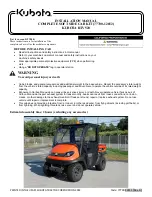
SECTION 00 – GENERAL INFORMATION
00-6
WARNING
Do not use your hand to check for leaks. Use a
piece of cardboard or paper to search for leaks.
Stop the engine and relieve pressure before
connecting or disconnecting lines.
Tighten all connections before starting the
engine or pressurizing lines.
If any fluid is injected into the skin, obtain medical
attention immediately or gangrene may result.
Use “position control” when equipment or implements
are required to be attached to the hydraulic linkage
either for testing purposes or for transportation.
Always lower equipment to the ground when leaving
the tractor.
If high lift attachments are installed on a tractor,
beware of overhead power, electric or telephone
cables when travelling. Drop the attachment near to
ground level to increase stability and minimize risks.
Do not park or attempt to service a tractor on an incline.
If unavoidable, take extra care and block all wheels.
Observe recommended precautions as indicated in
this Service Manual when dismantling the air
conditioning system as escaping refrigerant can
cause frostbite.
Prior to removing wheels and tires from a tractor,
check to determine whether additional ballast (liquid
or weights) has been added. Seek assistance and
use suitable equipment to support the weight of the
wheel assembly.
When inflating tires, beware of over inflation -
constantly check the pressure. Over inflation can
cause tires to burst and result in personal injury.
SERVICING A TRACTOR WITH A LOADER
INSTALLED
If the tractor is equipped with a loader, lower the
loader and rest the bucket on the ground.
If servicing the tractor and the loader must be raised,
empty the bucket and curl the bucket to fully retract
the bucket cylinders. Raise the loader and install the
loader supports over the cylinder rods and lower the
loader on the supports.
HEALTH AND SAFETY PRECAUTIONS
Many of the procedures associated with vehicle
maintenance and repair involve physical hazards or
other risks to health. This section lists, alphabetically,
some of these hazardous operations, materials and
equipment associated with them. The precautions
necessary to avoid these hazards are identified.
The list is not inclusive; all operations, procedures,
and handling of materials should be carried out with
health and safety in mind.
ACIDS AND ALKALIS (SEE BATTERY ACIDS,
I.E., CAUSTIC SODA, SULPHURIC ACID)
Used in batteries and cleaning materials.
Irritating and corrosive to the skin, eyes, nose and
throat. Causes burns.
Avoid splashes to the skin, eyes, and clothing. Wear
suitable protective gloves and goggles. Can destroy
ordinary protective clothing. Do not breathe mists.
Ensure access to water and soap is readily available
for splashing accidents.
ADHESIVES AND SEALERS (SEE FIRE)
CAUTION
Highly flammable, combustible.
Generally should be stored in “NO SMOKING” areas;
cleanliness and tidiness while in use should be
observed, i. e., from applications where possible,
disposable paper should be dispensed to cover
benches. Containers, including secondary contain-
ers, should be labelled.
Solvent-Based Adhesives/Sealers (See Solvents)
Follow manufacturer’s Instructions
Water-Based Adhesives/Sealers
Those based on polymer emulsions and rubber
lattices may contain small amounts of volatile toxic
and harmful chemicals.
Skin and eye contact should be avoided, and
adequate ventilation provided during use.
Follow manufacturer’s Instructions
Resin-Based Adhesive/Sealers (i.e., Epoxide and
Formaldehyde Resin Based)
Mixing should only be carried out in well-ventilated
areas as harmful or toxic volatile chemicals may be
released.
Skin contact with uncured resins and hardeners can
result in irritation, dermatitis, and absorption of toxic,
or harmful chemicals through the skin. Splashes can
damage the eyes.
Provide adequate ventilation; avoid skin and eye
contact. Follow manufacturer’s instructions.
Find manuals at https://best-manuals.com








































